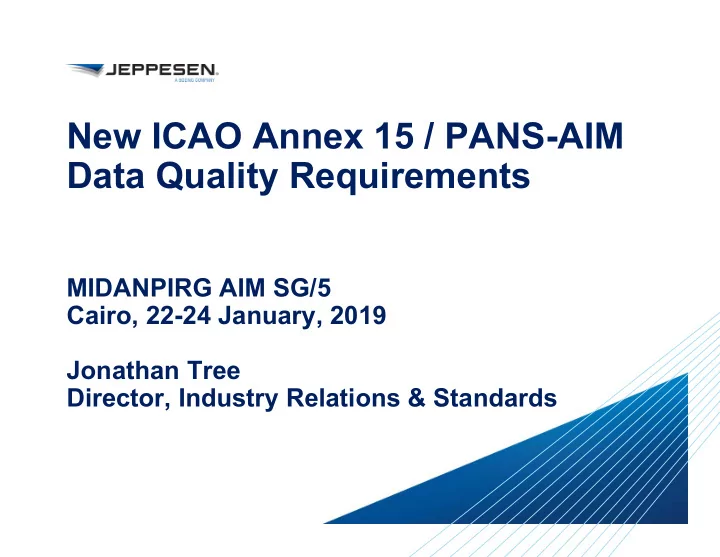

New ICAO Annex 15 / PANS-AIM Data Quality Requirements MIDANPIRG AIM SG/5 Cairo, 22-24 January, 2019 Jonathan Tree Director, Industry Relations & Standards
Data Quality Requirements in New Annex 15 DQRs come from the users. 2
Required Navigation Performance Required navigation performance (RNP): “A statement of the navigation performance necessary for operation within a defined airspace.” – ICAO Doc 4444 PANS-ATM
RNP Approach requires highest quality data Why is accuracy and resolution so critical in PBN, especially RNP ? Conventional Procedure • Truth is an ILS beam • The airplane flies a ground based signal that is always in the same position relative to the runway RNP Procedure • Truth is the database • The airplane flies to the waypoint in the database, right or wrong
… The airplane flies to the waypoint, right or wrong Actual Runway Location (orange) Official AIP Location (blue)
Quality in a PBN World • Dependent on accurate data. • Nav system provides guidance to waypoints. • Wherever the database says they are! • Data is mission critical. 6
https://yandex.ru/video/search?filmId=18077642699709443842&text=queenstown%20airport% 20RNP%20video&noreask=1&path=wizard
Data Quality Requirements in New Annex 15 3.6 Quality management system 3.6.1 Quality management systems shall be implemented and maintained encompassing all functions of an AIS, as outlined in 2.2. The execution of such quality management systems shall be made demonstrable for each function stage. Note.— Guidance material is contained in the Manual on the Quality Management System for Aeronautical Information Services (Doc 9839). Recommendation. — Quality management should be applicable to the 3.6.2 whole aeronautical information data chain from data origination to distribution to the next intended user, taking into consideration the intended use of data. Recommendation. — The quality management system established in 3.6.3 accordance with 3.6.1 should follow the ISO 9000 series of quality assurance standards, and be certified by an accredited certification body. 8
Data Quality Requirements in New Annex 15 2.1 State Responsibilities 2.1.4 Each Contracting State shall ensure that the aeronautical data and aeronautical information provided are complete, timely and of required quality in accordance with 3.2 3.2 Data quality specifications – 3.2.1 Data Accuracy – 3.2.2 Data Resolution – 3.2.3 Data Integrity – 3.2.4 Data Traceability – 3.2.5 Data Timeliness – 3.2.6 Data Completeness – 3.2.7 Data Format 9
Data Quality Requirements in New Annex 15 10
Data Quality Requirements in New Annex 15 3.2.4 Data Traceability 3.2.4.1 Traceability of aeronautical data shall be ensured and retained as long as the data is in use. 3.2.5 Data Timeliness 3.2.5.1 Timeliness shall be ensured by including limits on the effective period of the data elements. Note 1.— These limits may be associated with individual data elements or data sets. Note 2.— If the effective period is defined for a data set, it will account for the effective dates of all of the individual data elements. 3.2.6 Data Completeness 3.2.6.1 Completeness of the aeronautical data shall be ensured in order to support the intended use. 3.2.7 Data Format 3.2.7.1 The format of delivered data shall be adequate to ensure that the data is interpreted in a manner that is consistent with its intended use. 11
Data Quality Requirements in PANS-AIM CHAPTER 2. AERONAUTICAL INFORMATION MANAGEMENT … 2.2 Data integrity monitoring and assurance … Note.— Guidance material in respect to the processing of aeronautical data and aeronautical information is contained in RTCA Document DO-200B and European Organization for Civil Aviation Equipment (EUROCAE) Document ED- 76A — Standards for Processing Aeronautical Data . 12
Data Quality Requirements in RTCA DO-200B Format The format characteristic refers to the data structure. The format of delivered data should be adequate to ensure the data is interpreted in a manner consistent with the intent of the data. For transmission or upload, two potential formats are available for aeronautical data: human readable or digital. With the advent of cross-industry standardization, highly structured mark-up languages, such as the Extensible Markup Language (XML) tend to replace the simpler human-readable formats based on position in the row/column (e.g., ARINC 424) or field separators (e.g., NOTAM format). There is also a trend for the definition of conceptual/logical data models from which the data coding specification is derived. This facilitates the use of different coding formats, adapted to local needs, while ensuring interoperability through a common semantic model. 13
Data Quality Requirements in PANS-AIM CHAPTER 2. AERONAUTICAL INFORMATION MANAGEMENT … 2.1.2 Processing … Note 3. —Supporting data quality material in respect of data accuracy, publication resolution, and integrity of aeronautical data, together with guidance material in respect to the rounding convention for aeronautical data, is contained in Radio Technical Commission for Aeronautics (RTCA) Document DO-201A and European Organization for Civil Aviation Equipment (EUROCAE) Document ED- 77 — Standards for Aeronautical Information (or equivalent). 14
Data Quality Requirements in RTCA DO-201A 2.4.5 Volume of Changes for a Single AIRAC Cycle Planning authorities need to be aware that major changes such as a re-design of the State's airspace can place large demands on the aviation industry if the changes are scheduled for a single AIRAC cycle. This is more severe when the re-design effects TMA, arrival and departure routes in addition to a large number of en route airways. There remain many RNAV systems with fundamental limits to their database storage capacity that restrict the volume of change that can be held in an on-board database. Where large volumes of changes are anticipated by the State, it is requested that close coordination be maintained with the users to ensure that the new data can be adequately incorporated into industry systems. In addition, earlier distribution of the changes will also assist in resource scheduling . 15
THANK YOU!
Recommend
More recommend